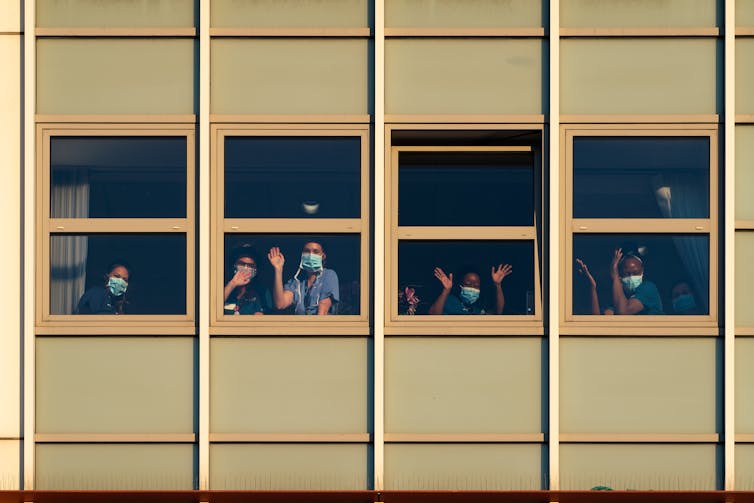five years on, COVID is still hurting the financial health of the NHS
- Written by Catia Nicodemo, Professor of Health Economics, Brunel University of London

The NHS was hit hard by COVID. And no amount of appreciative clapping or painted rainbows could distract from the vulnerabilities which were exposed by the pandemic – or the challenges it created.
Some of those challenges – like the staggering backlog in patient care, or the huge mental and physical toll experienced by staff – will take years to overcome.
And anyone compelled to attend a hospital in the UK at the moment can see the evidence at first hand. Wards are very busy and staff are overstretched[1].
This is part of the legacy of a fast-spreading virus which killed 232,112 people[2] in the UK and left an estimated 2 million[3] suffering from the effects of long-COVID. It demanded urgent action from hospitals and health workers and brought immediate and widespread disruption to routine care, with appointments for elective surgery, cancer screenings and chronic disease management all delayed.
One 2024 study[4] I worked on analysed appointment cancellations for cancer patients during the pandemic, and found that they waited an average of 19 days longer than before for rescheduled appointments. (Mortality rates remained stable though, indicating that the NHS effectively prioritised the most urgent cases.)
This kind of disruption has left the healthcare system facing a monumental backlog, with treatment waiting lists soaring to record levels. According to the British Medical Association, there are over 7.5 million people[5] now on waiting lists (compared to 4.5 million before the pandemic) – and those waiting times are longer.
Cutting this waiting list is apparently one of the prime ministers’s priorities[6]. But there is no easy fix.
The basic infrastructure of the NHS – the buildings, IT equipment, offices – is creaking[7], with outdated facilities, insufficient beds and a lack of specialised equipment. And one study suggests that capital funding – investment in assets that will be used for more than a year – for NHS trusts in England is down by 21%[8] over the past five years.
This is primarily because the Department of Health and Social Care has been diverting long-term investment funds to cover day-to-day operational costs such as staff salaries and medicines.
Since 2019, £500 million of capital investment has been cancelled or postponed[9]. And while overall NHS budgets have been growing, the increased spending has often been absorbed[10] by inflation, rising demand and the need to address immediate pressures. This leaves little for infrastructure upgrades, new equipment or technological advancements.
The Health Foundation has warned[11] that the lack of a long-term capital funding strategy could further jeopardise patient care in the future. Many NHS facilities no longer meet the needs of a modern health service, with some hospitals requiring complete refurbishment or replacement rather than just repairs.
And of course, treating patients is not just about equipment and buildings. Nurses and doctors are under extreme pressure, facing unprecedented levels of stress, burnout and trauma. A recent survey[12] revealed that one in three NHS doctors are experiencing extreme tiredness, impairing their ability to treat patients effectively.
A similar number said their ability to practice medicine may have been negatively affected by fatigue, with some even reporting cases of patient harm or a near-miss incident.
And although the NHS workforce has actually grown[14] over the past five years, it has not been sufficient to reduce waiting lists, deal with growing demand, or improve staff morale. Anxiety, stress and depression accounted for[15] for over 624,300 working days lost[16] in one month last year.
Without a healthy and motivated workforce, the NHS’s recovery efforts will remain severely hampered. Other contributing factors include increased demand for healthcare services, partly due to an ageing population[17] and the growing prevalence[18] of chronic conditions.
To address these challenges, the NHS needs a modernised approach to patient care. Research suggests that technology including telemedicine (online consultations) and AI-driven diagnostics, could streamline services and reduce waiting times[19].
Other possible steps[20] include the expansion of community diagnostic centres, to ease access to tests, and screenings, to improve efficiency.
Overall, the pandemic has underscored the critical importance of a robust and resilient healthcare system. As the NHS navigates its own path to recovery, it must prioritise both immediate solutions to the backlog crisis and long-term strategies. This will require significant investment, but also a commitment to innovation and the wellbeing of healthcare workers.
The road ahead for the NHS will be tricky, but with the right measures in place, it could emerge stronger and more resilient than ever. The lessons learned from COVID should serve as a catalyst for transformative change, ensuring that the UK’s healthcare system is better prepared to face whatever the future may hold.
References
- ^ overstretched (nhsproviders.org)
- ^ killed 232,112 people (ourworldindata.org)
- ^ estimated 2 million (theconversation.com)
- ^ 2024 study (www.sciencedirect.com)
- ^ 7.5 million people (www.bma.org.uk)
- ^ prime ministers’s priorities (www.lbc.co.uk)
- ^ is creaking (news.sky.com)
- ^ 21% (www.health.org.uk)
- ^ cancelled or postponed (www.health.org.uk)
- ^ often been absorbed (assets.publishing.service.gov.uk)
- ^ has warned (www.health.org.uk)
- ^ recent survey (www.mddus.com)
- ^ Guy William/Shutterstock (www.shutterstock.com)
- ^ actually grown (www.kingsfund.org.uk)
- ^ accounted for (pubmed.ncbi.nlm.nih.gov)
- ^ 624,300 working days lost (digital.nhs.uk)
- ^ ageing population (commonslibrary.parliament.uk)
- ^ growing prevalence (www.health.org.uk)
- ^ reduce waiting times (link.springer.com)
- ^ Other possible steps (www.gov.uk)







